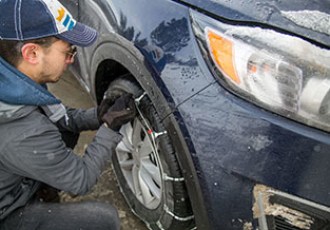BestReviews is reader-supported and may earn an affiliate commission. Details
We recommend these products based on an intensive research process that's designed to cut through the noise and find the top products in this space. Guided by experts, we spend hours looking into the factors that matter, to bring you these selections.

Driving straight isn’t a problem for most people but turning often is. In fact, one out of every five automobile accidents takes place in a parking lot, and the vast majority of those occur while people are backing up or turning — or both.
One reason for the prevalence of parking-lot accidents is the feeling of false security that parking lots engender. But another reason is that turning and backing up in confined spaces can be hard.
Enter the steering wheel spinner. One of these little gadgets can give you a little more oomph when you turn the steering wheel. Many people have preconceived ideas that steering wheel spinners are only for truckers, farm equipment drivers, or disabled individuals. Spinners are certainly useful in those situations, but in fact, anyone can use a steering wheel spinner anywhere. That being the case, which steering wheel spinner should you get? We’ll help you work through the decision-making process and drive home some safety tips along the way.

If you Google “steering wheel spinner,” you’ll find a plethora of websites claiming that steering wheel spinners are illegal. Part of the problem is that spinners are also known as suicide knobs, prompting many to assume they are unsafe and illegal. They’re not, but the name and the myth persist. The name “suicide knob” is the result of poor driving practices used by truckers before the advent of power steering.
Back in the day, truckers had the habit of turning their rigs one-handed using a spinner and then letting go of it when their turn was completed (but before they had a grip on the wheel with their other hand). This resulted in the wheel snapping back hard, often hitting the driver’s hand with enough force to cause serious injury. It also created a dangerous situation if the driver didn’t regain control.
Since the invention of power steering, that sequence of events has dramatically decreased. A car will still try to self-correct to a certain degree when you take your hand off the wheel or the spinner — but without the fast and dangerous recoil of yesteryear.
Contrary to popular opinion, steering wheel spinners are legal in all 50 states. Most states don’t even mention spinners in their vehicle codes. In the few states that do, such as Oregon, the mention is limited to mandating that construction equipment have power steering if a steering wheel spinner is to be used.
The thickness of your steering wheel’s outer ring must be measured so you know which spinners will work for your car. Most wheels have a diameter about an inch thick, but some cars have “skinny” wheels. The clasp on some spinners won’t be able to grip skinny wheels tightly unless you wrap a layer of foam rubber or some other material around the wheel to increase the thickness. If the spinner isn’t held tightly in place, it will slip during use. That’s worse than not having one at all. Note: if you have a steering wheel cover on your wheel, choose a wheel spinner that can accommodate any added thickness of the cover.
You’ll have to determine where on the wheel to put the spinner. It should be located where it won’t interfere with your normal driving. Sit in your car and take the wheel as if you were preparing to drive it. Look at the placement of your hands (everyone is different) then put the spinner where your hands won’t bump into it. Many users decide that between 11 o’clock and 1 o’clock on the wheel is a good position for a steering wheel spinner.
How far do you tilt your steering wheel? If you tilt it down too far, the clamp on the spinner could catch your clothes when you’re spinning. You may need to adjust the steering wheel slightly for smooth operation.
The type of clamp on a steering wheel spinner is important. You don’t want the spinner slipping when you’re trying to turn. You can hurt yourself in a hurry that way, not to mention whoever or whatever you run into if you lose control of your car. Think twice if a clamp doesn’t have screws that can tighten and lock the spinner in place.
The best clamps will have the screw coming up from beneath the knob. You may have to twist yourself into a pretzel to install it, but it will hold tight. Other types have screws that go in from the top down. These are easier to install, but the screws attach from both sides of the wheel, inside and out. Anything that sticks out from the wheel has the potential to snag your clothes when you’re getting in and out of the car.

Steering wheel spinners typically cost from $10 to $30 or even more. The highest prices usually correspond to larger models designed for use with big rigs. Price is only loosely tied to quality when it comes to steering wheel spinners, so shop carefully, whatever your chosen price range.


Q. What is the most common use for steering wheel spinners?
A. Steering wheel spinners are commonly seen on long-haul trucks, tractors, and construction equipment.
Q. Is there anyone who is prohibited from using steering wheel spinners?
A. No. If you have a valid driver’s license, you can use a steering wheel spinner.
Get emails you’ll love.
Learn about the products you’re wondering if you should buy and get advice on using your latest purchases.
